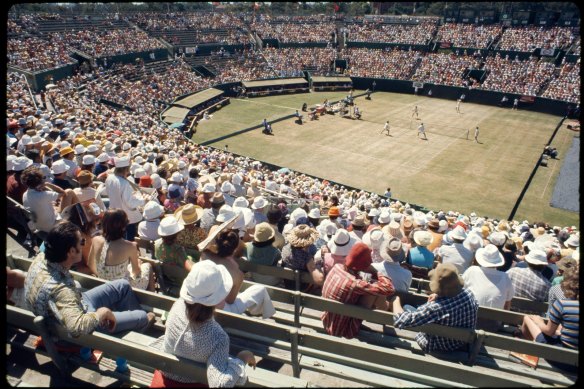'Out of control' and 'awful': Documentary aims to reveal real ...
AUSTRALIA’S OPEN ★★★½
(M) 99 minutes
The Australian sporting spirit takes a heavy knock in the first few minutes of this feature documentary, which charts the evolution of our grand slam tennis tournament, the Australian Open.

Nick Kyrgios poses for a selfie with fans after his first-round win at the Australian Open, a match rival Liam Broady discusses in the documentary Australia’s Open. Credit: AP
Liam Broady, an unassuming British player ranked at 93 in the world, is reliving the time he came up against Nick Kyrgios at the Open. It was the first time he had qualified for the tournament and friends had assured him the experience would be fun. But Kyrgios’ voluble army of fans booed him from the moment he stepped on the court and went on booing him throughout. It was, he says, “absolutely awful”.
Pat Cash, meanwhile, observes that crowds have got “a little out of control in recent years”. Others put it more bluntly. They see an ugly brand of nationalism behind the catcalls.
The documentary makes clear the futility of arguing that tennis and politics should never mix. Martina Navratilova and John McEnroe put a big dent in that claim when they condemned Margaret Court’s opposition to the marriage equality referendum in 2017 by taking a banner on to the court asking that Margaret Court Arena be renamed in honour of Evonne Goolagong. And in 2022, Novak Djokovic’s brief stay in a Melbourne immigration detention hotel – imposed for his refusal to be vaccinated against COVID – produced a bitterly ironic side effect. The world was suddenly alerted to the plight of asylum seekers who had been confined to the hotel for years.

The old centre court at Kooyong in 1988.
Although the documentary makes the point that the Open has more cameras trained on it than any of the other grand slam tournaments, it’s disappointingly short on candid moments. Director Ili Bare has taken a conventional approach to the story, rounding up a panel of commentators and former players who serve up insights and anecdotes about the tournament’s history, starting with its Kooyong days in the 1970s when it struggled to attract international players.
Some wrote it off as a grass court attached to a suburban tennis club, and Josh Frydenberg, who was Kooyong Open Champion in 1996, remembers sneaking into the ground as a schoolboy. The tournament’s prospects improved dramatically with its move to Melbourne Park in 1988, and its status is now secured as the first grand slam of the tennis year leading up to Paris, Wimbledon and New York.
Sport has a way of inspiring platitudes and hyperbole, and they’re in plentiful supply here as the case is put for the Open’s significance as a reflection of the changes seen by Australian society over the years.
Loading
There is also nostalgia for the heyday of those beloved titans of the game, Roger Federer and Rafael Nadal. Journalist George Megalogenis remembers 2017 as the peak of the “happy Slams”, while the ABC’s Tracey Holmes has fond memories of the arrival of the Williams sisters. Tennis was so white, she says, before they burst on to the scene with their incomparable blend of sisterly sportsmanship and pure showbiz.
Bare has given us a good and occasionally stirring rundown on the highlights and lowlights of Australian tennis, together with the Open’s political and social dimensions, but nobody on screen really gets to grips with the fascinations of the game and the mysterious conjunction of instinct, intellect, temperament and athleticism that distinguishes the great players from the rest. And a little backstage drama would also have helped.
Australia’s Open is released in cinemas on October 12.
Loading





































































